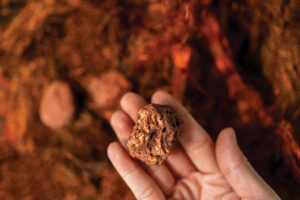Pilbara gold believer Novo Resources plans to start bulk-mining next year

Pic: John W Banagan / Stone via Getty Images
Canada’s Novo Resources — the key player in the Pilbara gold story — wants to start mining the region next year even though it hasn’t been able to give any indication of grade or resource for its local conglomerate gold projects.
“We’ve identified numerous places along strike where we see potential bulk extraction sites,” chairman Quinton Hennigh told delegates at the Precious Metals Investment Symposium in Perth this week.
“Our goal for next year is to get to the point where we can go and bulk-mine this thing.”
Conglomerate gold refers to nuggets hosted in rock containing rounded grey quartz pebbles and other minerals — a common sight in the Pilbara.
The world’s most productive gold region, South Africa’s Witwatersrand Basin, is famous for similar geological formations.
Investors have been keenly awaiting news of grade and resource, but Novo is still keeping mum.
- Subscribe to our daily newsletter
- Join our small cap Facebook group
- Follow us on Facebook or Twitter
Canadian billionaire backer Eric Sprott said it’s probably easier to just start mining.
Mr Sprott is Novo’s second biggest shareholder with 10 per cent — while his gold miner Kirkland Lake Gold holds 18 per cent.
“We got involved with Novo, and I’m involved with Novo, because we believe in the Pilbara,” he told delegates at the Precious Metals conference.
“Nobody knew this let’s say 18 months ago that there was gold over 600km by 300km, but we know it now. There is gold.
“We don’t know whether that gold is economic, or exactly how to identify it or actually how to mine it in conglomerate when it’s underneath something, but we know the gold is there.
“And we don’t know unfortunately grade and I think we at Novo have spent a lot of time on the science of trying to come up with what’s exactly the grade here.
“It might very well be that the greater opportunity is just get the mining licence.”
Novo recently acquired private explorer Farno-McMahon, which already has two mining licences in the Egina region of Western Australia.
UNLOCK INSIGHTS
Discover the untold stories of emerging ASX stocks.
Daily news and expert analysis, it's free to subscribe.
By proceeding, you confirm you understand that we handle personal information in accordance with our Privacy Policy.








